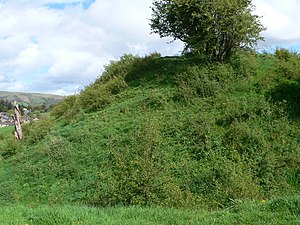Builth Castle
| Builth Castle | ||
|---|---|---|
|
The Moth from Builth Castle |
||
| Creation time : | 11th century | |
| Conservation status: | ruin | |
| Geographical location | 52 ° 8 '55.7 " N , 3 ° 23' 49.5" W | |
|
|
||
Builth Castle is a former castle in Wales in the United Kingdom . The castle site, protected as a Scheduled Monument , is on the outskirts of the town of Builth Wells in Powys . The castle was one of the first castles that King Edward I had built during his castle building program to secure the conquest of Wales .
history
Anglo-Norman frontier castle in the 12th and 13th centuries
Around 1100 the Anglo-Norman baron Philip de Braose conquered the Cantref Builth and built a first wooden castle fortified with earth walls at a strategically important river crossing over the River Wye , where the roads to Brecon and the Irfon valley met in the west. Around 1168 the castle was captured and destroyed by Rhys ap Gruffydd . The rebuilt castle was fiercely contested between the Barons of Braose and the Welsh in the following years. After the territories of William de Braose, 4th Baron of Bramber were confiscated by King John Ohneland in 1208 , it was recaptured in 1215 by William's son Reginald with the support of the Welsh prince Llywelyn ap Iorwerth . After Reginald, however, in 1217 a settlement with the new English King Henry III. had closed, attacked his nephews Owain ap Gruffydd and Rhys Ieuanc on behalf of Llywelyn 1217 Builth, but could not conquer the castle. A siege by Llywelyn itself also failed in the Anglo-Welsh War of 1223 after an English army under Hubert de Burgh advanced as relief. During the campaign of Henry III. after Ceri , Reginald's son William, 7th Baron of Bramber, was captured by Llywelyn in 1228. Terms of his release included the delivery of Builth as part of his daughter Isabell's dowry, who married Llywelyn's son Dafydd ap Llywelyn . Dafydd's father Llywelyn probably had the castle demolished to the ground in the 1230s. After Llywelyn's death in 1240, the Crown claimed Builth and John de Monmouth began building a new stone castle. From December 1256 the new castle was repeatedly attacked by Dafydd's successor and nephew Llywelyn ap Gruffydd until he was finally able to conquer it on July 17, 1260 and had it destroyed again.
Re-erection as a royal fortress
At the beginning of his campaigns in Wales , King Edward I began rebuilding the castle in 1277 to secure his conquests. Presumably according to plans by its builder James of St. George , the castle was expanded into a mighty stone fortress. Construction of the castle was not yet completed when Llywelyn ap Gruffydd came to Builth in 1282 during his revolt against English rule. The exact purpose of the visit is unclear, the fact is that on the way back to his troops at Cilmeri, about 3 km west of Builth, he was ambushed and killed by English soldiers. The further construction of the castle was stopped after this English success. During the uprising of Madog ap Llywelyn the castle was besieged in 1294, but the rebels could not take it immediately and the castle was finally appalled by an English army under John Giffard . In the 14th century the castle, still unfinished in 1343, was temporarily owned by the Mortimer family, the Earls of March . Edmund Mortimer, 2nd Baron Wigmore , died in 1304 while fighting near the castle. During the uprising of Owain Glyndŵr in 1401 the castle was occupied by a garrison led by John Oldcastle . The castle was badly damaged by a siege but could not be captured by the rebels.
Decay from the 16th century
The castle fell into disrepair in the late Middle Ages and was used as a quarry from the 16th century. After the great city fire of Builth around 1690, many of the houses were probably rebuilt with stones from the castle, so that the walls of the castle were completely removed. Today only the remains of the earth fortifications remain from the castle. The castle site is now on the outskirts of the city and is freely accessible.
investment
The first castle of the 12th century was built on a hill south of the Wye as Motte with two courtyards, making it one of the largest fortifications of the time. In 1277 the castle began to be expanded into a mighty stone fortress with a round keep on the castle hill, which was surrounded by a curtain wall with six towers. Another curtain wall was built around this central castle. Access to this outer courtyard was through a mighty gatehouse flanked by two towers. Within the courtyard there were other stone buildings, including the hall, farm and residential buildings and a chapel. Nevertheless, this complex was the smallest of the castles that Edward I had built to secure his rule in Wales .
The castle site is at the east end of town, south of the bridge over the Wye. All that remains of the castle are the 18 m high castle hill, the earth wall leading around the castle and the moats.
literature
- Christopher Gravett; Adam Hook: The castles of Edward I in Wales, 1277-1307. Osprey, Oxford 2007. ISBN 978-1-84603-027-7 .
Web links
Individual evidence
- ↑ Ancient Monuments: Builth Castle. Retrieved September 18, 2013 .
- ^ Clwyd Powys Archaeological Trust: Builth Castle. (PDF; 1.0 MB) Retrieved September 18, 2013 .
- ^ David Walker: Medieval Wales. Cambridge University Press, Cambridge 1990. ISBN 978-0-521-31153-3 , p. 96.
- ↑ Michael Prestwich: Edward I. University of California Press, Berkeley 1988, ISBN 978-0-520-06266-5 , p. 221.
- ^ Builth Wells: History. Retrieved September 22, 2013 .


